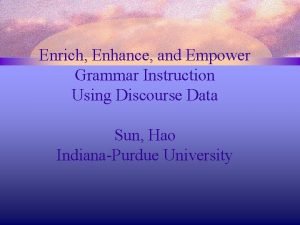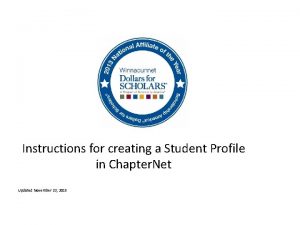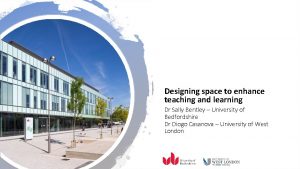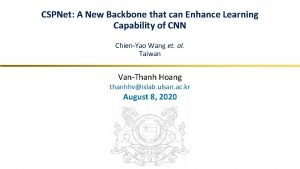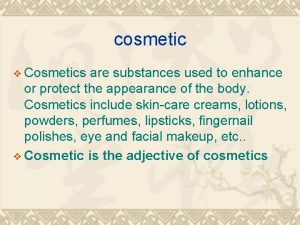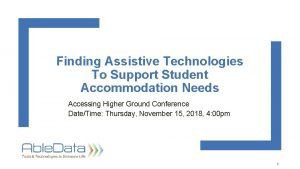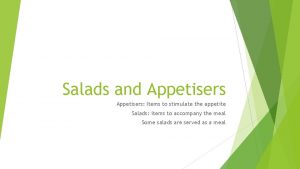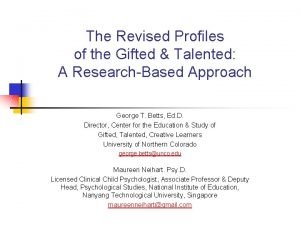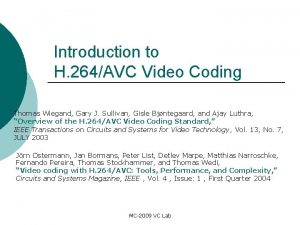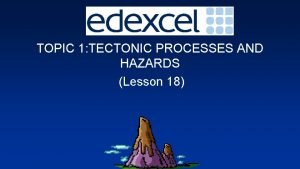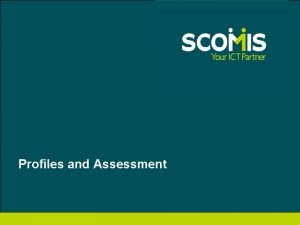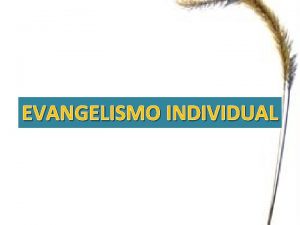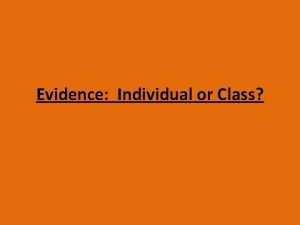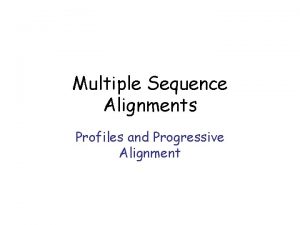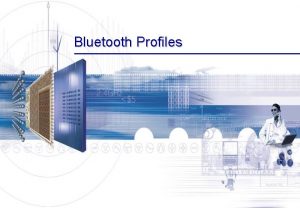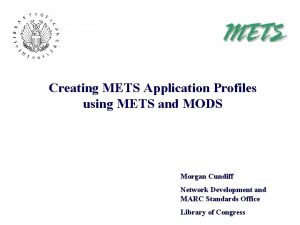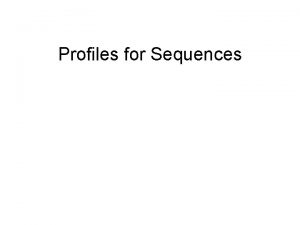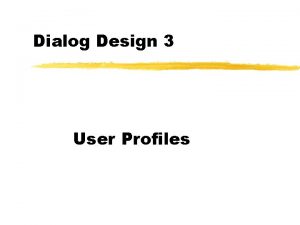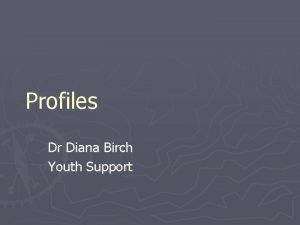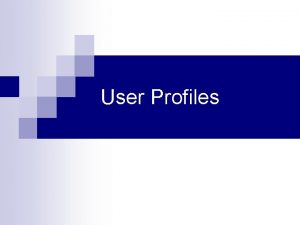Creating and Using Individual Student Profiles to Enhance

















- Slides: 17

Creating and Using Individual Student Profiles to Enhance Student’s Math Achievement CASS Fall Conference Calgary, AB. November 8, 2019 Dr. John M. Burger

Session Topics Welcome, in this session we will address: • 1) how educational leadership data analytics (ELDA) are symbiotic phenomenon within the SLQS • 2) foundations for measuring individual student engagement with the SOS-Q • 3) how a Student Information System can address a school’s questions: e. g. why are so many students failing Math 9? • 4) share ideas on better supporting student’s Math achievement

What is ELDA? • “Schools and districts are awash in data, from more traditional data…to more recent innovations…. Education Leadership Data Analytics (ELDA) helps school leaders make sense of the data… through applying …data science analytic techniques to educational issues that are important to teachers, principals, superintendents, parents, and most importantly, students. ” see: https: //www. tc. columbia. edu/elda/ and https: //www. intellimedia. ca

Applied ELDA directly impacts Leading Learning, Visionary Leadership and Operations and Resources synergistically Indicator 6 e. Establishing data-informed strategic planning and decisionmaking processes that are responsive to changing contexts

Student Engagement: Two Schools of Thought • “PISA results indicate that drive, motivation and confidence in oneself are essential if students are to fulfil their potential. ” P. 21 • “Teachers and school principals need to be able to identify students who show signs of lack of engagement with school and work with them individually before disengagement takes firm root. ” P. 22 • Student engagement is complex and many variable combinations are possible – value in opening a dialogue and following-up. PISA 2012 Results in Focus: What 15 -year-olds know and what they can do with what they know. OECD. Available @ https: //www. oecd. org/pisa/keyfindings/pisa-2012 -results-overview. pdf

Student Orientation to School Questionnaire (SOS-Q) https: //www. practicaldatasolutions. ca SAFE & CARING SCHOOL Perception of how supportive the school environment is, including teacher supports (UE; JSH) EXTERNAL RESILIENCE Perceived ability to cope with external challenges and adversities (UE; JSH) INTERNAL RESILIENCE Ability to resist anxiety and maintain emotional balance (UE; JSH) SELF-CONFIDENCE Conviction of capability to be successful at school and beyond (UE; JSH) PEERS Ability to get along with peers and perceived friends’ support (UE; JSH) UTILITY OF SCHOOL Sense of usefulness of school for future career and post-secondary success (JSH) EXTRA-CURRICULAR ACTIVITIES Participation opportunity and perceived value (JSH) Upper-Elementary (UE); Junior-Senior High (JSH) - includes optional school-work balance and school-work integration for students working part time

SOS-Q Validation • Internal measurement properties of the SOS-Q (factor structure and reliability) have been consistently assessed with multiple data sets. • Exploratory and confirmatory factor analyses have converged on a stable and reliable measurement structure for both upper elementary and jr. /sr. high versions of the scale. § Moving beyond achievement data: Development of the Student Orientation to School Questionnaire as a non-cognitive assessment tool - Burger, Nadirova & Keefer, 2012, Journal of Psychoeducational Assessement, 30, 367 -386. http: //journals. sagepub. com/doi/full/10. 1177/0734282912449444 § A study of the factorial invariance of the Student Orientation to School Questionnaire (SOS-Q): Results from elementary and high school students” - Nordstokke, Colp, Burger & Nadirova – under review, Alberta Journal of Educational Research

Student Information System: Individual and Cohort SOS-Q Profiles Stud 1 2 3 4 5 6 7 8 9 10 11 12 `3 14 15 16 17 18 19 20 21 22 23 Z Ext. Resil. Z Self. Conf Z Peer s Z Int. Resil. Z Extra. Curric Activ. Z Utility Sch. Z Total Avg 1. 0 -3. 9 1. 0 -4. 6 1. 0 -5. 1 1. 0 -4. 9 5. 0 2. 1 2. 5 -1. 3 1. 0 -4. 1 1. 5 -5. 4 2. 3 --2. 0 1. 3 -4. 0 1. 0 -5. 1 1. 25 -4. 5 1. 0 -2. 5 2. 1 -2. 0 1. 0 -4. 1 1. 6 -5. 1 1. 9 -2. 6 1. 8 -3. 2 1. 2 -4. 8 1. 3 -4. 5 1. 5 -2. 0 3. 0 -0. 3 2. 5 -2. 1 2. 0 -4. 3 2. 2 -2. 2 3. 36 -0. 6 3. 5 -1. 0 3. 6 -0. 7 3. 5 0. 3 3. 25 0. 2 2. 33 -2. 4 3. 11 -0. 9 4 0. 5 2. 91 -1. 4 3. 83 -0. 5 3. 2 -1. 4 2. 5 -0. 8 2. 75 -0. 8 2. 83 -1. 7 3. 15 -0. 9 3. 13 -0. 8 3. 18 -0. 9 2. 2 -3. 1 3. 4 -1. 0 4. 75 1. 8 2. 88 -0. 5 3 -1. 5 3. 22 -0. 9 2. 33 -2. 0 2. 45 -2. 2 4. 67 0. 9 2. 8 -2. 0 3 -0. 3 4. 12 1. 9 3. 33 -1. 1 3. 24 -0. 7 3. 4 -0. 4 4. 55 1. 4 4. 17 0. 0 3. 6 -0. 7 2 -1. 4 2. 25 -1. 7 3 -1. 5 3. 28 -0. 6 3. 47 -0. 3 2. 9 -1. 4 3. 33 -1. 3 3. 8 -0. 4 3. 5 0. 3 2. 5 -1. 3 3. 83 -0. 4 3. 33 -0. 7 3. 4 -0. 4 3. 18 -0. 9 3. 67 -0. 8 3. 4 -1. 0 3. 33 0. 1 3. 12 0. 0 3. 5 -0. 8 3. 37 -0. 6 3. 4 -0. 4 3. 64 -0. 2 3. 5 -1. 0 3. 2 -1. 4 3. 25 0. 0 3 -0. 3 4 -0. 1 3. 43 -0. 5 3. 8 0. 2 2. 91 -1. 4 3. 83 -0. 5 3 -1. 7 3. 75 0. 6 2. 88 -0. 5 4. 17 0. 1 3. 48 -0. 5 4. 8 1. 7 3. 82 0. 1 4. 67 0. 9 4. 6 0. 9 2. 75 -0. 5 3. 88 1. 5 5 1. 2 4. 22 0. 8 4. 15 0. 7 3. 82 0. 1 4. 83 1. 1 4. 6 0. 9 4. 75 1. 8 4. 12 1. 9 3. 33 -1. 1 4. 23 0. 8 4. 6 1. 4 4. 09 0. 6 4. 67 0. 9 4. 6 0. 9 3. 25 0. 0 3. 38 0. 5 5 1. 2 4. 23 0. 8 4. 86 1. 8 4. 91 2. 0 4. 5 0. 6 5 1. 5 3. 33 0. 1 2. 88 -0. 5 5 1. 2 4. 35 0. 9 4. 73 1. 6 4. 55 1. 4 4. 83 1. 1 4. 75 1. 1 3. 25 0. 0 3 -0. 3 5 1. 2 4. 30 0. 9 4. 8 1. 7 4 0. 4 5 1. 4 4. 8 1. 2 3 -0. 3 3. 5 0. 7 5 1. 2 4. 30 0. 9 4. 67 1. 5 4. 64 1. 5 4. 67 0. 9 4. 25 0. 3 3. 25 0. 0 3. 88 1. 5 5 1. 2 4. 34 1. 0 4. 53 1. 3 4. 27 0. 9 4. 6 0. 9 3. 5 0. 3 4. 25 2. 2 4. 67 0. 8 4. 36 1. 0 4. 4 1. 1 4. 73 1. 7 4. 67 0. 9 5 1. 5 3. 75 0. 6 3. 75 1. 2 4. 83 1. 0 4. 45 1. 1 4. 36 1. 0 4. 17 0. 0 4. 8 1. 2 5 2. 1 4. 75 3. 2 4. 5 0. 5 4. 56 1. 3 4. 4 1. 1 4. 55 1. 4 4. 4 0. 6 4. 75 1. 8 4. 5 2. 7 5 1. 2 4. 66 1. 4 Safe/ Caring Avg Z

2014 Path Diagram http: //www. rockyview. ab. ca/jurisdiction/research/sos-q/assessingstudentorientation Alberta Journal of Educational Research, Vol. 60, No. 2, Summer 2014, 300 -321

Classroom-Based Grade 9 Math Achievement Predicted by Previous Achievement and Attendance Dependent Variable: 2016 -17 Classroom-Based Grade 9 Math Unstandardized Coefficients Standardized Coefficients B Std. Error Beta t Sig. Classroom-Based Math 8 Mark (%): 2016 -17 . 866 . 087 . 668 10. 231 . 000 Math 6 Standardized Provincial Achievement Test (PAT) (%): 2014 -15 . 205 . 063 . 196 3. 224 . 002 Attendance (% of School Days Attended): 2016 -17 . 393 . 34 . 156 2. 927 . 004 Constant = - 52. 411 R Square =. 74, Adjusted R Square. 73; N = 119

Classroom-Based Grade 9 Math Achievement Predicted by Student Orientation to School Model 1 2 SOS-Q Constructs (5 -Point Scale) B Std. Error Beta t Sig Self-Confidence 8. 640 2. 592 . 327 3. 333 . 001 Extracurricular 2. 955 2. 277 . 127 1. 298 . 197 Constant = 30. 547 R Square =. 16; Adjusted R Square =. 14 Self-Confidence 4. 071 3. 937 . 154 1. 034 . 304 Extracurricular 2. 045 2. 426 . 088 . 843 . 401 Safe & Caring School -. 994 4. 947 -. 030 -. 201 . 841 External Resilience 11. 145 4. 797 . 320 2. 323 . 022 Internal Resilience . 879 2. 133 . 040 . 412 . 681 Utility of School . 600 3. 360 . 027 . 178 . 859 -4. 640 2. 904 -. 169 -1. 598 . 113 Peers Constant = 29. 107 R Square =. 22; Adjusted R Square =. 16 N=107

Math Anxiety and Achievement • Gunderson, Park, Maloney, Beilock and Levine defined math anxiety as, “a negative affective reaction to situations involving math. ” • Math anxiety seems to be specific to the math domain independent of other academic domains and can create worries that can interfere with working memory thus suggesting a complex social- emotional – cognitive connection. • Meece, Wigfield & Eccles found that students’ current performance expectances and perceived importance of math had strong direct effects on anxiety.

Grade 9 Students Math Achievement Classified in Three Clusters and SOS-Q Profiles Z scores

Key Conclusions • Student engagement assessed via the SOS-Q can help identify non-cognitive variables predicting academic achievement. • Building external resilience and self-confidence in students can contribute to strategies to increase math achievement. • Value –added data analytics linked with social-emotional assessments can: • Diagnose and unpack factors affecting achievement Support students “at risk” of disengaging from school or a specific subject; Open dialogue with students and parents to better understand positive connections to school and achievement pathways. Web-based SOS-Q introduces effective and efficient access to measuring student affect and timely action on results.

Recommendations 1. If a student achieves a low mark in Math 8, provide a transition course prior to enrolling in Math 9 based on item analysis of Math 8 final exam. 2. Share research on Math achievement factors and the predictive power of these factors (e. g. attendance 1 day =. 4%) with students to empower them to define their own achievement strategies. 3. Assess the degree of self-confidence and math phobia (external resilience) and council individual students or cohorts on ways to counteract these phenomena. 4. Use this and similar research with k-9 staff to stimulate a holistic, system-wide Math improvement plan.

What’s Next? • Construct and apply accurate and comprehensive student information systems. • Further develop student supports informed • • • by student information systems including affective data. Duplicate this research in additional settings – potential partners? Share research with AE to stimulate discussion of implications for Math 9 curriculum design and supports. Share evolving work on better supporting students Math achievement – what strategies have worked in your context or are you considering?

CONTACTS AND INFORMATION johnburger@shaw. ca or 403 816 3268 www. practicaldatasolutions. ca For a full copy of the paper, visit • https: //storage. googleapis. com/wzuk users/user 23965263/documents/5 bfc 4 eaae 50 d 4 z PVupjl/ICERI%20%20 Paper%20%20 Final. pdf
 Voice translation profile
Voice translation profile Grammar to enrich and enhance writing
Grammar to enrich and enhance writing Creating a student profile
Creating a student profile Fashion cycle
Fashion cycle Enhance an image
Enhance an image Cspnet
Cspnet Cosmetics are substances that are used to enhance
Cosmetics are substances that are used to enhance Enhance an image
Enhance an image Nyjc promotion criteria
Nyjc promotion criteria Enhance life
Enhance life A salad that stimulate appetite
A salad that stimulate appetite Can hypnosis force people to act against their will
Can hypnosis force people to act against their will Profiles of the gifted and talented
Profiles of the gifted and talented H.264 profiles and levels
H.264 profiles and levels Distortion welding defect
Distortion welding defect Hazard profile examples
Hazard profile examples Who is jean louise in to kill a mockingbird
Who is jean louise in to kill a mockingbird Process discriminants in software project management
Process discriminants in software project management

